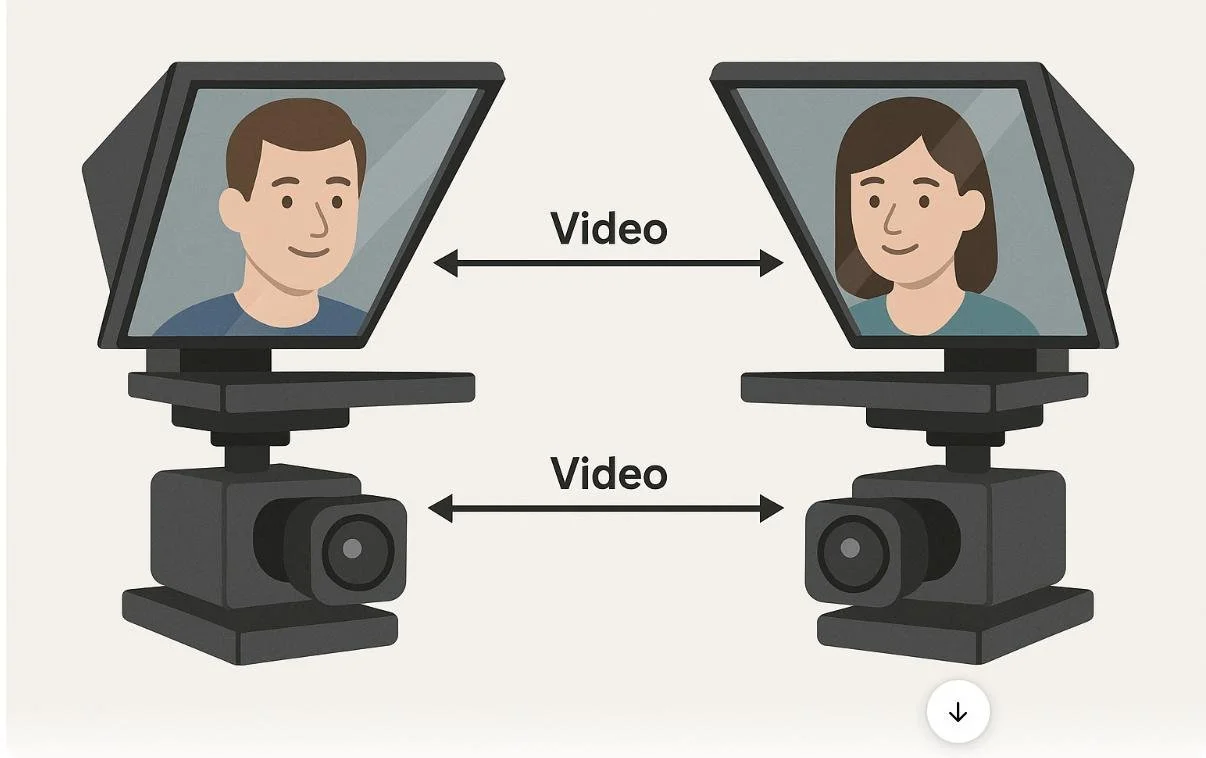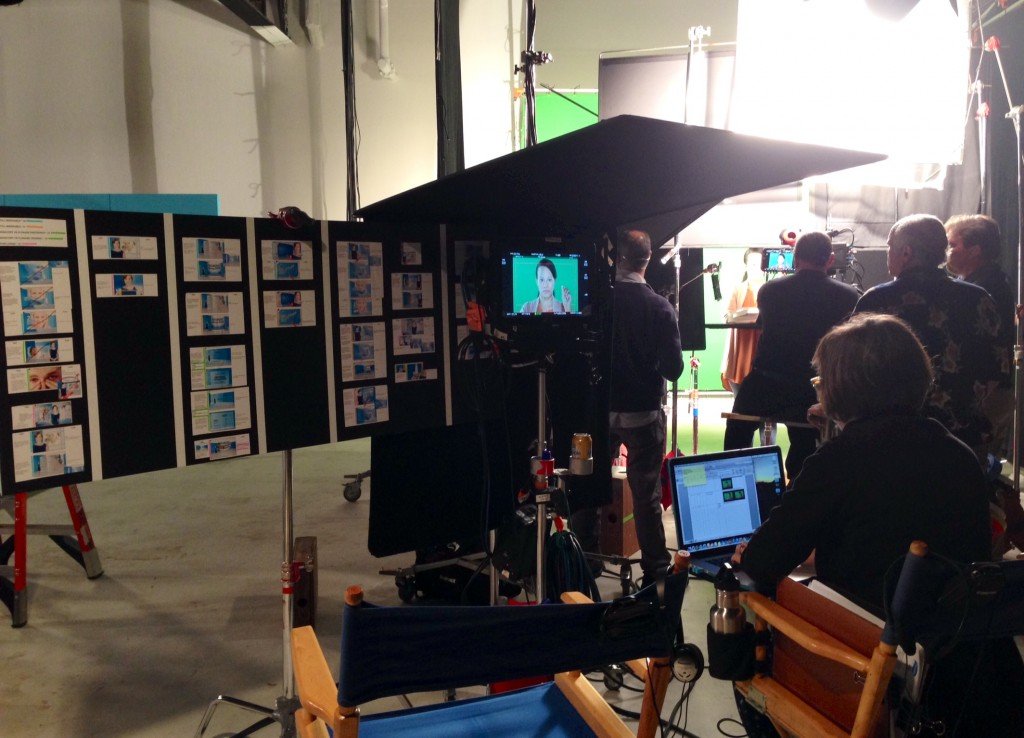Interrotron Rental
Interrotron Teleprompter Rental
Interrotron Mark III - $1,295
Interrotron Road Warrior - $1,295
Get in touch
Interrotron Mark |||
Both Talent & Director Share the Same Space
Talent Unit on camera or on stand
Professional Monitor
High Bright 1000+ NITS
HDSDI & HDMI
Director’s Unit
Professional Monitor
High Bright 1000+ NITS
Tripod
Professional Camera
Small Tripod
Interrotron Road Warrior
Talent In Studio | Director In Studio or Another Location
Talent Unit On Camera or on Stand
Professional Monitor
High Bright 1000+ NITS
HDSDI & HDMI
Director’s Unit
Skytronn Remote Unit
Director’s Face Seen on Talent Monitor
Talent Seen By Director “face to face” Over Zoom
Other Client Producers Able to Watch Over Zoom
Interrotron Road Warrior
This version of the classic Interrotron features two “Talent Units.”
Thus, the client has the ability to use two high-end matched cameras such as Alexa Mini’s, REDs, F55s, Venice, etc., with two matched talent units so that two subjects can talk to each other, “eye to eye”, looking directly into the lens and be recorded in, say 4K or 8K or whatever, by a professional camera.
An operator accompanies the device.
The professional Mark IV is a dual unit system that allows the director to see the subject and have access to the framing, lighting, and color correction.
The Mark IV has professional video monitors so that the director sees the subject properly composed. Both video monitors on the Mark IV are 1080p HD.
Simultaneously the director can have a comfortable, accurate, and productive “one-on-one” conversation with the subject while monitoring the technical aspects of the shot.
The studio version talent unit is a modified, professional “gold plate” Autocue Teleprompter. It can easily accept RED, Phantom, Alexa, F55 Venice, and most professional cameras on its sliding rod and plate system.
It accepts every type of camera output: HDMI, HD-SDI. Each has a “pass-through” for additional monitor access.
The Interrotron is delivered and operated by a professional technician.
The Interrotron can also function as a Standard Teleprompter and be switched in seconds by the operator.
Three Versions:
Studio, Remote & Two Camera
The Interrotron Road Warrior
INTERROTRON
The Interrotron allows you to get the best shot, the first time!
With its dual teleprompter units creating a “face-to-face” dynamic, it captures a more natural performance. From the talent’s unit, the director/interviewer’s image is reflected onto the front of the lens. This provides them with direct engagement towards the center of the camera. On the other end, the director’s unit allows you to see the subject, so you can check for framing, correct coloring, or adjust lighting.
ROAD WARRIOR
Interrotron Technology
It allows the familiar “face to face” personalized interaction between the director and subject… but at a distance.
The director could be in Hollywood and the interview subject in Manhattan and still get that highly personal “one-on-one conversation.
It is more authentic. More honest. More visceral. (Academy Award?)
This makes directors happy.
And because great interview responses are often gotten on the first take… it saves time and money.
This makes producers happy.
And now more time and money can often be saved by remotely directing the talent through the lens of the camera while also having access to other views of the set, lighting arrangement, etc.
Naturally, this is a great tool for casting.
One could just stream the casting session but more and more top directors want to control the final “call back sessions” by personally interacting with the candidates through the actual camera lens via “Interrotron at a distance”.
INTERROTRON
Interrotron Mark III HD
The Interrotron inventor, Errol Morris, won an Academy Award for his deeply personal interview style using the unit. His wife is credited with coining the term which is a union of the words “Interview” and “Terror”.
INTERROTRON
Interrotron Style Direct Gaze and Neurocognition
Recent quantitative studies in the areas of neurocognition reveal deep-seated connections between eye-to-eye communication, and brain activity: 4-month-old human infants prefer to look at faces that engage them in mutual gaze. Neuroscientists have documented marked increases in their brain electric activity when interactions are accompanied by direct gaze (Farroni et al., 2002).
Likewise, a 2011 study proposed that a live face with a direct gaze is processed more intensely than a face with an averted gaze or closed eyes, as the direct gaze is capable of intensifying the feeling of being the target of the other’s interest and intentions. “Direct gaze elicited greater face-sensitive N170 amplitudes and early posterior negativity potentials than averted gaze or closed eyes, but only in the live condition,” (Pönkänen et al. 2011).
INTERROTRON DIRECT ADDRESS ISSUES
With direct-address video and film interviews proliferating, fundamental questions about the nature of encounters it facilitates remain unaddressed. The nature and scope of this design investigation seek to establish and define a more formal investigative process of the technique. By employing techniques of participatory design research in a series of direct address interviews I hope to generate insightful responses and reflections about the nature of direct-address based interviewing:
What does it feel like to be the subject of a direct address video interview?
Does the machine promote a more balanced, more level, perhaps more egalitarian encounter?
Do slight variations in hardware orientation facilitate or hinder this leveling?
Does it enable insights and connections for the interviewing participants that are hitherto unavailable using conventional face-to-face techniques?
Does it enable insights and connections for the interviewing participants that are hitherto unavailable using conventional face-to-face techniques?
Likewise, can the device leverage improve listening memory and empathy?
What would subjects, given public access to such a device make with it?
Is the direct-address appropriate for all video-recorded situations?
The Interrotron allows you to get the highest standard shots the first time.
Interrotron vs. EyeDirect: A Practical Breakdown
| Interrotron | EyeDirect | |
|---|---|---|
| Core Concept | Remote-controlled teleprompter system enabling direct eye contact by showing the interviewer’s face in the lens. | Mirror-based system that reflects the interviewer’s face (or a camera lens) onto the interviewee’s eyeline. |
| Design & Setup | Two-camera system: Camera A records the subject, Camera B shows the interviewer’s live video feed through a teleprompter. | Single-camera system with mirrors: Reflects interviewer’s face into subject’s eyeline; simple, portable. |
| Portability | Less portable; requires two cameras, monitors, and power. | Highly portable; one compact unit that mounts to the camera. |
| Technical Complexity | Higher: Needs multiple cameras, video feed transmission, and setup. | Lower: No external video feeds; plug-and-play with DSLR/cinema cameras. |
| Cost | More expensive (rental or purchase); professional studio setup. | Less expensive; available as a single unit, no extra gear. |
| Ideal Use Cases | High-profile interviews, celebrity shoots, films, broadcast TV. | Corporate videos, testimonials, low-budget interviews, ENG. |
| Eye Contact Fidelity | Best: Feels like the interviewer is “there” in the lens; perfect for authentic reactions. | Very good: Interviewer appears in eyeline, but with some limitations in large setups. |
| Interviewer Location | Remote or off-set possible; interviewer can be in another room or location entirely. | Interviewer must be physically present near the camera. |
| Script/Teleprompter Use | Can double as a teleprompter for scripted lines and questions. | Cannot function as a teleprompter for scripts; purely for eye contact. |
| Example Usage | Errol Morris documentaries, network TV interviews (e.g., 60 Minutes). | Corporate testimonials, YouTube videos, docu-style content |
1. What Is an Interrotron?
The Interrotron is a brilliant piece of filmmaking technology that allows interview subjects to look directly into the camera while maintaining natural eye contact with the interviewer. Invented by legendary documentarian Errol Morris, it uses a dual teleprompter system: one in front of the camera and one facing the interviewer. This creates an intimate, face-to-face dynamic that captures authentic, emotionally engaging performances. Whether you’re filming a corporate testimonial, a celebrity interview, or a powerful documentary moment, the Interrotron delivers that rare connection between subject and viewer that’s hard to replicate.
2. Why Is an Interrotron So Useful?
The Interrotron is incredibly valuable because it solves a classic problem in filmmaking: interview subjects tend to glance off-camera when speaking to an interviewer, making them appear distracted or disconnected. With the Interrotron, they’re looking directly into the lens, speaking to a familiar face yet still engaging the audience head-on. This leads to more powerful storytelling, greater viewer trust, and far more emotionally resonant content. It’s especially useful with nervous talent or non-actors, helping them relax and communicate more naturally. For directors and producers, it’s a simple yet transformative tool that dramatically elevates on-camera performance.
3. Who invented the Interrotron?
Errol Morris, an Academy Award-winning documentary filmmaker, invented the Interrotron. He designed it to help nervous subjects feel more comfortable and deliver more authentic performances on camera.
4. How does an Interrotron work?
The system uses two teleprompters, one for the interviewer and one for the subject. Each displays a live camera feed of the other person’s face. This setup enables real-time, face-to-face communication while maintaining perfect eyeline with the recording camera.
5. Why is eye contact with an Interrotron so important in interviews?
Direct eye contact creates a sense of trust and intimacy with the viewer. It’s especially crucial in political addresses, testimonials, and documentaries where authenticity is everything. The Interrotron helps deliver that connection.
6. What types of productions benefit from using an Interrotron?
Corporate interviews
Executive keynotes
Political messages
Nonprofit PSAs
Documentaries
Testimonials
Branded content
Essentially, any video where natural delivery and eye contact matter.
7. Is an Interrotron difficult to operate?
Not at all. The system is typically operated by a trained technician or teleprompter operator. At American Movie Company, our experienced crew handles everything from setup to operation so your team can focus on the content.
8. Can the Interrotron be used with any camera?
Yes. Interrotron systems are compatible with most professional broadcast and cinema cameras. Our team ensures that your camera setup is properly mounted and aligned.
9. Can I use the Interrotron remotely or for virtual interviews?
Yes, this configuration is often called the Road Warrior Interrotron. The director / Interviewer can be "across the room or across the country"
TeleprompterRental.com offers remote "Road Warrior" Interrotron solutions, enabling live interviews between people in different locations perfect for virtual productions or remote leadership messaging.
10. Is an Interrotron only useful for nervous or inexperienced speakers?
No, even seasoned professionals benefit from the Interrotron. It allows for a more engaging, confident performance, making even scripted lines feel spontaneous and heartfelt.
11. Do you offer Interrotron rentals with operator support?
Absolutely. American Movie Company and TeleprompterRental.com provide full-service Interrotron rentals, complete with delivery, setup, and a skilled operator. We serve all major media markets in North America.
Ready to book or want a demo?
Call us at 212-219-1075 or visit AmericanMovieCo.com.
Let us help you connect with your audience, eye to eye.





